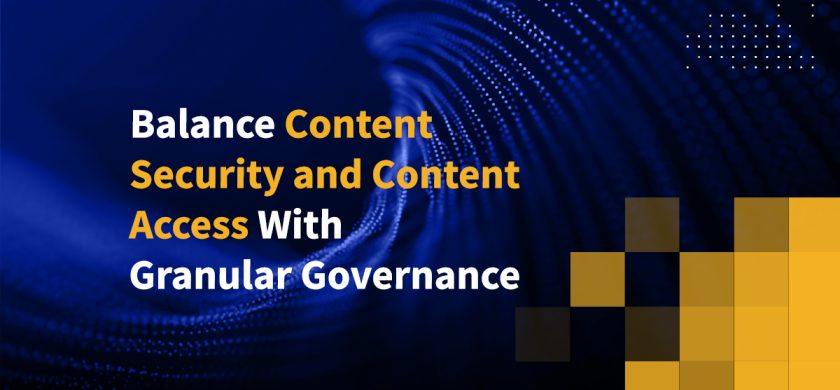
Balance Content Security and Content Access With Granular Governance
Every CISO knows that you can’t have privacy without security, however, you can have security without privacy. Multi-factor authentication, data encryption, and threat protection defend against external threats, but they do nothing to ensure sensitive content is handled correctly by authorized users. While users across your extended enterprise expect easy access to their sensitive content, they also expect complete confidentiality: transparent collaboration comprised of private communications.
CISOs must enable secure file sharing that balances the protection of sensitive content with the overwhelming need to share it, easing access while preventing breaches, ensuring privacy alongside transparency, and adhering to complex regulations without getting in the way of efficient communication. Each trade-off entails risks. This blog series explores these trade-offs and offers six guiding principles for creating a secure content sharing channel that enables work across the extended enterprise and protects your most sensitive digital assets.

In my last blog post, I shared some of the pitfalls associated with providing simple, seamless access to content. Today, I’ll discuss the challenge organizations have in providing easy access to sensitive content, but also ensuring that content is shared with complete confidentiality.
Understand User Roles to Enforce Policy Controls
Confidentiality is the result of strong content communication governance – ensuring only authorized users can access, modify and share specific content in specific ways. It cannot be enforced at the network level—where most security controls are implemented, because it requires information like who, what, where, when, and how. It must be enforced at the user-application-content level, because that is where this information resides. For example, preventing a finance manager from sharing audited statements publicly prior to an earnings announcement requires an understanding of user roles, content type and timing of the request. These requirements echo my earlier blog post about the requirements for total visibility: connection to every user sharing endpoint and every content repository. Only now we need more than just a connection—confidentiality requires control.
Complete Content Confidentiality Requires Complete Content Control
Your secure content sharing channel must have very granular policy controls based on a wide array of inputs, including user roles and privileges, as well as content metadata, such as file size, type, location, read and write permissions, and content sensitivity. Consider file access at a hospital. Should a podiatrist have access to an obstetrics patient’s records? Should an admitting clerk be able to edit a patient’s prescription dosage? Not if the hospital wants to demonstrate HIPAA compliance. This is the baseline to govern data at rest. To govern data in motion as it enters and leaves your organization, policy controls need to incorporate sharing metadata, such as sender, receiver, origin, destination, time of transfer, and window of availability. The more granular the governance, the greater your ability to enforce confidentiality and strike the right balance between privacy and transparency.
In the next post, I’ll discuss how organizations can prevent employees from building their own shadow IT out of easily accessible, consumer cloud applications. Until organizations make it simple to share sensitive content securely, they will force employees to seek out less cumbersome, and also less secure, alternatives.
To learn more about providing easy access to sensitive content while also ensuring that content is shared with complete confidentiality, schedule a custom demo of Kiteworks today.
Frequently Asked Questions
Third-party risk management is a strategy that organizations implement to identify, assess, and mitigate risks associated with their interactions with third-party vendors, suppliers, or partners. These risks can range from data breaches and security threats to compliance issues and operational disruptions. The process typically involves conducting due diligence before engaging with a third party, continuously monitoring the third party’s activities and performance, and implementing controls to manage identified risks. The goal is to ensure that the third party’s actions or failures do not negatively impact the organization’s operations, reputation, or legal obligations.
Third-party risk management is crucial because it helps to identify, assess, and mitigate the risks associated with third-party relationships. This can include cybersecurity threats, compliance issues, operational risks, and reputational damage.
Policy controls are essential in third-party risk management as they establish clear expectations for third-party behavior, data handling, and security practices. They help mitigate the risk of security incidents by defining acceptable actions, and ensure third parties comply with relevant laws, regulations, and industry standards. Further, policy controls provide a foundation for monitoring third-party activities and enforcing compliance, allowing the organization to take appropriate action in case of policy violations. Thus, policy controls serve as a critical framework for managing third-party risks effectively.
Audit logs are integral to third-party risk management as they offer a comprehensive record of all third-party activities within your systems. They aid in identifying potential risks by highlighting unusual or suspicious activities, serve as a crucial resource during incident response and forensic investigations, and help ensure regulatory compliance by providing proof of effective security measures and third-party monitoring. In addition, they foster a culture of accountability and transparency among third parties, deterring malicious activities and encouraging adherence to security policies.
Kiteworks helps with third-party risk management by providing a secure platform for sharing and managing sensitive content. The platform is designed to control, track, and secure sensitive content that moves within, into, and out of an organization, significantly improving risk management. Kiteworks also provides two levels of email encryption, Enterprise and Email Protection Gateway (EPG), to secure sensitive email communications. This helps to protect against third-party risks associated with email communication.
Additional Resources